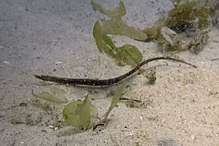Campichthys tryoni
Campichthys tryoni (Tryon's pipefish) is a species of marine fish of the family Syngnathidae.[2] Little is known of this species, but the specimens that have been collected were found on the Queensland coast off of northeastern Australia.[1] It is a rare mainly tan coloured pipefish with brownish markings, it has a white blotch over the eyes, a pale patch above the operculum and it has small white dots along its back and tail. The males frequently show irregular dark barring along their ventral surface.[3] This species is ovoviviparous, with males carrying eggs in a brood pouch until giving birth to live young.[2] The largest known specimen is 7.2 centimetres (2.8 in) long, while males may brood at roughly 6–6 centimetres (2.4–2.4 in).[1] The species was described by James Douglas Ogilby in 1890 from a specimen collected in Moreton Bay, Queensland in 1886 and the specific name honours his friend, Mr Henry Tryon, with whom he enjoyed a collecting trip in Moreton Bay.[4] It is a listed Marine species in Australia under the Environment Protection and Biodiversity Conservation Act 1999.[3]
| Tryon's pipefish | |
|---|---|
 | |
| Scientific classification | |
| Kingdom: | Animalia |
| Phylum: | Chordata |
| Class: | Actinopterygii |
| Order: | Syngnathiformes |
| Family: | Syngnathidae |
| Genus: | Campichthys |
| Species: | C. tryoni |
| Binomial name | |
| Campichthys tryoni (Ogilby, 1890) | |
| Synonyms[1] | |
| |
References
- Austin, D. & Pollom, R. (2016). "Campichthys tryoni (errata version published in 2017)". IUCN Red List of Threatened Species. 2016: e.T65364201A115412457.
- Froese, Rainer and Pauly, Daniel, eds. (2018). "Campichthys tyroni" in FishBase. February 2018 version.
- Thompson, V.J. & Bray, D.J. (2017). "Tryon's Pipefish, Campichthys tryoni (Ogilby 1890)". Fishes of Australia. Museums Victoria. Retrieved 24 May 2018.
- D.J. Ogilby (1890). "Descriptions of two new species of Australian Lophobranchiate fishes". Records of the Australian Museum. 1 (3): 55–56. doi:10.3853/j.0067-1975.1.1890.1225.
